A solid fishing reel can be the difference between landing the big one and watching it swim away with your lure in its mouth. Fishing companies know the importance of the right gear, and there are tons of options out there. In this article, we’ll wade through the confusion, explaining technical terms, reviewing some of the best spinning reels out there (for your wallet, too), and ultimately picking the cheap and high-end winners for saltwater, freshwater, and specific fish.
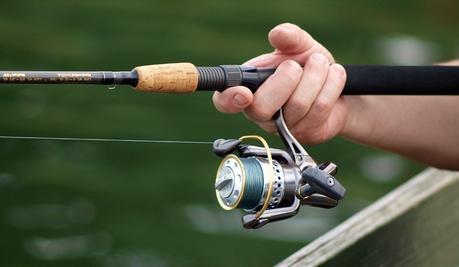
Spinning Reel Buying Guide
- Read: Choosing Spinning Reels or Baitcasting Reels?
If you’re looking for a beginner reel for kids, spincast (closed-face) reels are the easiest to operate, or if you’re looking for a precision casting reel for exclusively bass, baitcast may be a better choice. Spinning (open face) reels are a great all-around choice, and that’s what we’re focusing on here today. The fixed, open spools don’t tangle like baitcasting reels and allow feather-light line and lures to be cast with ease.
Here’s what to look for when buying a spinning reel:
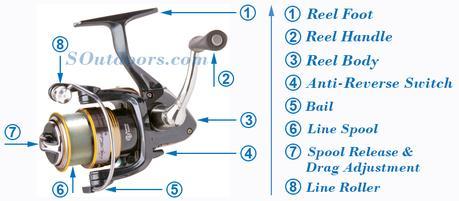
- Quality construction: Higher-quality materials lead to a higher-quality reel. Look for all-metal construction with, if possible, an aluminum body and spool and sealed, stainless steel bearings. A top-of-the-line reel will last a lifetime.
- Specificity: Different fish and different conditions call for different reels. If you’re not going for a specific fish, or you don’t really know, a good place to start is the size. To find the right one, determine the test strength of the line you’ll be using. The middle line capacity will be printed on the spool; for example, if it says 8 LB/175 YDS, that reel is built to handle 6 and 10 pound line as well. 175 yards is how much normal fishing line (aka monofilament) that spool can hold.
- Power: The gear ratio of the reel will determine how easily it will get your fish out of the water. A lower gear ratio, meaning the bail wraps line fewer times around the spool for each turn of the crank, will give you more torque for larger fish. 4:1 is a typical low gear ratio. A higher gear ratio, such as 6:1, will retrieve, or “pick up,” faster, bringing in smaller fish quicker. If you’re not sure, look for a happy medium of 5:1.
- Resistance: With an open-face design, spinning reels naturally have very little resistance. This is important for smooth retrieval, but also for casting; with less resistance, it’s possible to precision cast smaller, lighter baits. A good determinant for the smoothness in a reel is the number of ball bearings it has. Look for at least five, and spring for more if your wallet can handle it. Above five, an inexperienced fisherman likely won’t be able to tell the difference. All of the reels we’re reviewing have over five ball bearings.
- Drag: While resistance is bad, a proper drag system is a necessity. It’s responsible for letting out line while you’re in the heat of battle. A jerky, restrictive system will raise the probability of the line pulling taut and breaking, so, at any tension, your reel should be smooth and consistent. Exposure to the elements degrades the reel over time, so the best of today’s drag systems are sealed and waterproof.
- Retrieve: A quality reel won’t move backwards when setting the hook. It will lock tight, allowing you to set the hook, and then it will stack line fluidly and evenly onto the spool. “Birds-nest” is not a word you want to describe your line.
- Weight: Heavier reels stress your joints and exhaust your hands and arms much faster than lighter ones. More expensive reels aren’t necessarily lighter, because there’s also oftentimes a quality tradeoff here; aluminum, a stronger, more durable, and less flexible metal than graphite, also weighs more. Ultimately, even in the upper echelon of reels, you’ll have to decide whether longevity or weight is more important to you.
Best Spinning Reel 2017 Reviews
- Read: Best Rod and Reel Combo 2017 – Buyer’s Guide
I. Best Cheap Spinning Reels
1. Okuma Avenger ABF Graphite Bait Feeder Reel
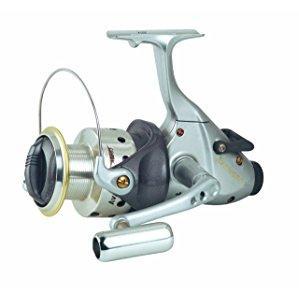
Features: The Okuma Avenger ABF sports a 5:1 gear ratio, six stainless steel sealed ball bearings, a waterproof drag seal, a graphite body, and an aluminum spool.
Pros: Okuma’s proprietary live bait feeding system allows micro-adjustments to the drag, letting a fish pick up the bait and run without feeling the drag of the reel. The mixed graphite and aluminum components allow high-quality performance while maintaining a decent weight. The 5:1 gear ratio provides a nice medium between torque and speed.
Cons: To save weight, the handle is made of a mix of aluminum and plastic, which simply isn’t durable and won’t last under the stress of bigger fish. The bait feeding system introduces more moving parts to a relatively cheap system, also causing concerns about how long the reel will last.
Sizing: The Avenger comes in six sizes from the tiny ABF-20a to the enormous ABF-90a. Weights vary from 8.8oz to 27.6oz. The larger sizes provide a slightly lower gear ratio, 4.5:1, to assist with landing larger fish. The 30a, which is about what most casual fisherman would need, has a maximum drag of 12 lbs and weighs 11.8 oz while providing capacity for 180 yards of 10lb line.Best for: light use with light fish, even with the upper sizes, due to cheap materials in the handle.2. Pflueger President Spinning Reel
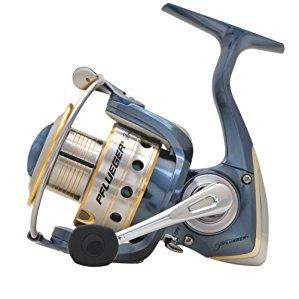
Features: Pflueger’s President has a 5.2:1 gear ratio, nine bearings, an aluminum handle and spool with weight-saving holes, stylish blue and gold accents, an anti-reverse clutch, and a graphite body.
Pros: The small size of this reel, and the variation in the small sizing (see sizing below), allows a precise fit and lets you really feel the fish. A combination of aluminum and graphite keeps quality up and weight down, while the nine bearings run smoothly, even with braided line.
Cons: The drag system is not shielded from the elements in any way, so longer-term exposure, especially to salt water, would reduce the durability of the President. The shaft is plastic where it attaches to the reel, raising concerns about durability, and as an “ultralight” reel, it won’t support weighty line or big fish.
Sizing: Five sizes, all ultralight, range from a mere 5.9 oz to a petite 10.9 oz, and from a maximum drag of 6 to 12 lbs. The largest can accommodate 230 yards of 10lb line.Best for: A precise feel for catching small fish.3. KastKing Sharky II Spinning Reel
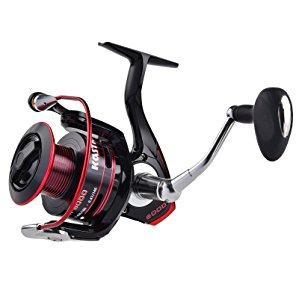
Features: The Sharky features a stainless steel shaft, 10 bearings, an aluminum spool, waterproof seals, and an anti-reverse clutch.
Pros: Incredibly high drag limits don’t mean a heavier reel for the Sharky. The performance is super smooth while the anti-reverse system means you’ll set the hook firmly every time.
Cons: The light weight comes with a high price. The spool’s sharply tapered lip gives resistance while casting, and the design makes it so the bail doesn’t always stay open when it should. Durability is also a concern with the cheap internal parts.
Sizing: Six sizes provide an insane range. The smallest size, at just 7 oz, gives a maximum drag of 11 lbs, while the highest boasts a whopping 41.5 lbs of maximum drag and a lower gear ratio of 4.9:1. The 2000 weighs 8.5 oz, provides a maximum drag of 17.5 lbs, and can hold 150 yards of 10 lb line.Best for: very casual use with larger fish.II. High End Spinning Reels
1. KastKing Triton Dualis Revolutionary Two-speed
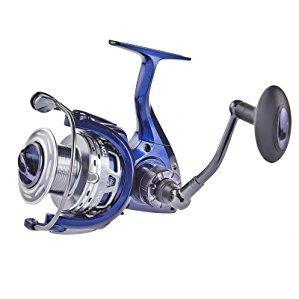
Features: Dual gear ratio, 10 ball bearings, aluminum handle, stainless steel shaft, graphite body
Pros: KastKing’s proprietary Dualis system allows you to shift your gear ratio during the retrieve, giving you incredible versatility in variable conditions. The ten bearings allow super smooth motion, and the reel is “saltwater approved,” which presumably means it’s sealed in some way. The stainless steel shaft provides strength you won’t see on cheaper models.
Cons: Although we didn’t have any problems with it, nor could we find anyone who did, extra complication in a design often means reduced durability. “Shielded” bearings might protect against salt corrosion, but they won’t have the same waterproofing upon immersion as sealed bearings will.
Sizing: Three sizes range from 12.5 oz to 24 oz. They tend to be on the larger end of reels, with the smallest providing a variable gear ratio of 4.7:1 and 6.7:1, a maximum drag of 13 lbs, and a capacity of 140 yards of 10lb line.Best for: large fish in freshwater.2. Penn Battle II Spinning Reel
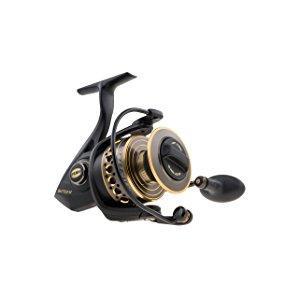
Features: This reel has five sealed, stainless steel, ball bearings; all metal construction in stylish black and gold trim; carbon fiber drag washers; and an instant anti-reverse mechanism.
Pros: Penn’s Battle II is a stalwart of the fishing industry. The construction will last forever, and even if you get a lemon, the simple internal mechanics and availability of parts (due to the popularity of the reel) make fixes much simpler than with other reels.
Cons: High gear ratios, from 5.2:1 to 6.2:1 depending on the size, might give less torque than is desired in a fight with a big fish. Five bearings are enough to be smooth, but more experienced fisherman might want a smoother motion.
Sizing: Eight sizes from 10.3 oz to 30 oz. The middle of the line provides 15 lbs of maximum drag and 165 yards of 10 lb monofilament capacity in a 12 oz package.Best for: One reel to rule them all, an all-arounder without the bells and whistles that will last forever.3. PENN Spinfisher V Spinning Reel
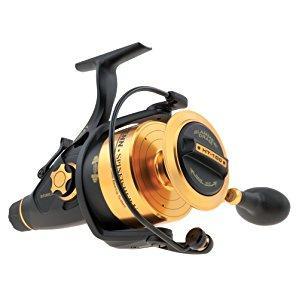
Features: A fully sealed, all metal body with an aluminum spool, five shielded ball bearings, and instant anti-reverse come standard. Gear ratios lower from 6.2:1 to 4.2:1 as the reels increase in size.
Pros: The fully sealed body keeps salt out, and shielded bearings will resist corrosion even if water does manage to penetrate the body. High quality parts mean this reel will run forever. The sheer variability in sizing and increased torque in the larger sizes help you get the features you need while not paying for those you don’t.
Cons: Just like Penn’s Battle II, five bearings won’t give the smoothest ride around. More importantly, this reel is HEAVY. Holding it for a while would be a chore.
Sizing: Ten sizes weigh from 14 to 43 oz and have maximum drags of 20 to 40 lb. The middle of the line 4500 model weighs 15 oz, has a maximum drag of 25 lb, and a capacity of 250 yards of capacity for 10 lb monofilament.Best for: Short forays into any environment for any fish, saltwater and big fish included.4. Penn Clash Spinning Reel
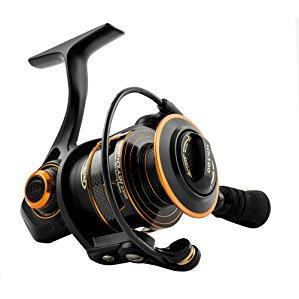
Features: This professional grade reel sports eight stainless steel ball bearings, a thick aluminum bail, an instant anti-reverse bearing, and full metal components. The gear ratio decreases from 6.2:1 to 4.7:1 for extra torque as the reels increase in size.
Pros: The sealed bearings run smoothly in any conditions, and the unsealed body keeps the weight down. Full metal components won’t break under any circumstances. The spool runs smoothly with braided line.
Cons: Despite Penn’s reputation and their high-quality components, we’ve heard horror stories about reels being shipped incomplete and others having terrible durability.
Sizing: Seven sizes from 8 to 28 oz provide maximum drags from 10 to 30 lbs. The middle of the road 3000 model weighs 10 oz, provides a maximum drag of 15 lbs, and has a 10 lb monofilament capacity of 165 yards.Best for: All-around freshwater performance.5. Shimano Stradic HG Spinning Reel Japanese Edition
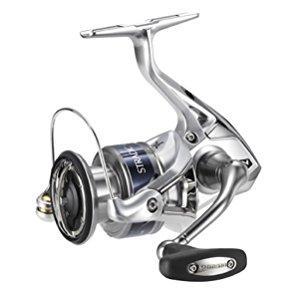
Features: The Stradic is built with cold-forged metal construction, six shielded ball bearings, an anti-reverse bearing, and a gear ratio of 6:1.
Pros: The R&D department at Shimano has been working overdrive: Shimano’s cold-forged Hagane technology makes this reel incredibly rigid, while numerous other technologies, like a meticulously designed spool lip design, increase performance. The high maximum drags are unheard of in a reel as light as this one, meaning you get the rare ability to feel every nibble while still having the toughness to land the big one.
Cons: A high gear ratio of 6:1 comes with less torque than might be desired with a heavy fish. The unsealed bearings aren’t meant for salt water.
Sizing: Shimano’s Stradic comes in six sizes, with one size being merely an option to increase the spool capacity at the cost of weight. The smallest is truly miniscule, with a weight of 7 oz, and the largest still isn’t that heavy, at 11 oz. The middle of the road offers a 24 lb maximum drag and a 10 lb capacity of 200 yards – and it weighs less than 10 oz.Best for: Long outings on freshwater with any size fish.Best Saltwater Spinning Reel
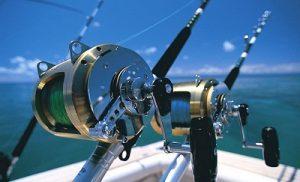
Our Picks
Cheap Reel: KastKing’s Sharky has the waterproof seals to keep you going back time and time again. The smooth bearings, ultra-high drag limits, and a low gear ratio give you what you need to pull up the Kraken – if you can hook it.
High-End Reel: The Penn Spinfisher V is widely regarded as the top saltwater spinning reel. With full seals bringing all-condition protection, high maximum drags to perform even with huge fish, and Penn’s legendary name behind you, this reel will run forever.
Best Freshwater Spinning Reel
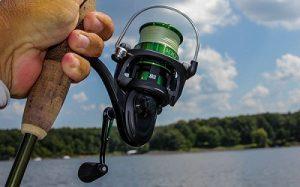
Our Picks
Cheap Reel: The Pflueger President is smooth and durable in its moving parts, doesn’t come with any unnecessary bells and whistles that shorten its longevity, and has the light weight and huge monofilament capacity to make this your reel of choice.
High-End Reel: Shimano, as a large sporting goods company known for quality, meticulously engineers every single part and delivers top-of-the-line performance. We’ll let the unsealed bearings on the Shimano Stradic slide for its superior performance, including astronomical maximum drags for a relatively low weight.
Best Spinning Reel for Bass, Trout, Crappie
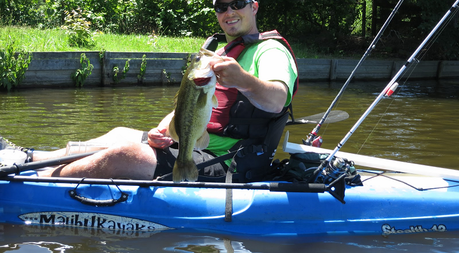
Best Bass Spinning Reel
Our Pick: The KastKing Triton Dualis, with its variable gear ratio, retrieves quickly for use with crankbait while maintaining the ability to reel in the big one. It provides precision while maintaining durability and performance.
Best Trout Spinning Reel
Our Pick: The light weight to feel any nibble, high capacity to reach deep down when trolling, and all-around versatility of the Shimano Stradic will have you landing trout wherever you are.
Best Crappie Spinning Reel
Our Pick: Because Pflueger’s President is ultralight, you’ll feel every nibble, and a high gear ratio will help you keep the line tight. There are so many models in this smaller line of reels that you can customize the fit to the size of the fish you’re likely to hook.
Conclusion
Even with so many options out there, finding the right reel doesn’t need to take hours of research. If you’ve made it this far, hopefully we helped you understand some of the technical terms that come with buying a reel, while also helping you come to conclusions about which reel is right for you. Good luck out there!

